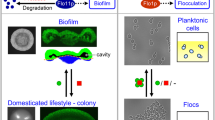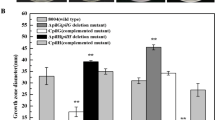Abstract
The ability of many microorganisms to modify adhesion-related properties of their cell surface is of importance for many processes, including substrate adhesion, cell–cell adhesion, invasive growth, pathogenic behaviour and biofilm formation. In the yeast Saccharomyces cerevisiae, a group of structurally related, cell-wall associated proteins encoded by the FLO gene family are directly responsible for many of the cellular adhesion phenotypes displayed by this organism. Previous research has suggested that the differential transcription of FLO genes determines specific adhesion phenotypes. However, the transcriptional regulation of most FLO genes remains poorly understood. Here we show that the transcriptional activator Mss11p, which has previously been shown to be involved in the regulation of starch degradation, the formation of pseudohyphae and haploid invasive growth, also acts as a strong inducer of flocculation. The data indicate that Mss11p induces flocculation together with Flo8p, and that FLO1 is the dominant target gene of the two factors in this process. The deletion of MSS11 leads to a non-flocculent phenotype, and specific domains of Mss11p that are critical for the induction of flocculation are identified. The data clearly show that several essential transcription factors are shared by at least two flocculation genes that control different adhesion phenotypes.




Similar content being viewed by others
References
Ausubel FM, Brent R, Kingston RE, Moore DD, Seidman JG, Smith JA, Struhl K (1994) Current protocols in molecular biology. Wiley, New York
Brachmann CB, Davies A, Cost GJ, Caputo E, Li J, Hieter P, Boeke JD (1998) Designer deletion strains derived from Saccharomyces cerevisiae S288C: a useful set of strains and plasmids for PCR-mediated gene disruption and other applications. Yeast 14:115–132
Braus GH, Grundmann O, Brückner S, Mösch H-U (2003) Amino acid starvation and Gcn4p regulate adhesive growth and FLO11 gene expression in Saccharomyces cerevisiae. Mol Biol Cell 14:4272–4284
Conlan RS, Tzamarias D (2001) Sfl1 functions via the co-repressor Ssn6-Tup1 and the cAMP-dependent protein kinase Tpk2. J Mol Biol 309:1007–1015
van Dyk D, Pretorius IS, Bauer FF (2005) Mss11p is a central element of the regulatory network that controls FLO11 expression and invasive growth in Saccharomyces cerevisiae. Genetics 169:91–106
Fleming AB, Pennings S (2001) Antagonistic remodelling by Swi-Snf and Tup1-Ssn6 of an extensive chromatin region forms the background for FLO1 gene regulation. EMBO J 20:5219–5231
Gagiano M, Van Dyk D, Bauer FF, Lambrechts MG, Pretorius IS (1999a) Divergent regulation of the evolutionary closely related promoters of the Saccharomyces cerevisiae STA2 and MUC1 genes. J Bacteriol 181:6497–6508
Gagiano M, Van Dyk D, Bauer FF, Lambrechts MG, Pretorius IS (1999b) Msn1p/Mss10p, Mss11p and Muc1p/Flo11p are part of a signal transduction pathway downstream of Mep2p regulating invasive growth and pseudohyphal differentiation in Saccharomyces cerevisiae. Mol Microbiol 31:103–116
Gagiano M, Bauer FF, Pretorius IS (2002) The sensing of nutritional status and the relationship to filamentous growth in Saccharomyces cerevisiae. FEMS Yeast Res 2:433–470
Gagiano M, Bester M, Van Dyk D, Franken J, Bauer F, Pretorius IS (2003) Mss11p is a transcription factor regulating pseudohyphal differentiation, invasive growth and starch metabolism in Saccharomyces cerevisiae in response to nutrient availability. Mol Microbiol 47:119–134
Gancedo JM (2001) Control of pseudohyphae formation in Saccharomyces cerevisiae. FEMS Microbiol Rev 25:107–123
Gietz RD, Sugino A (1988) New yeast-Escherichia coli shuttle vectors constructed with in vitro mutagenised yeast genes lacking six-base pair restriction sites. Gene 74:527–534
Guo B, Styles CA, Feng Q, Fink GR (2000) A Saccharomyces gene family involved in invasive growth, cell-cell adhesion, and mating. Proc Nat Acad Sci USA 97:12158–12163
Jones JS, Prakash L (1990) Yeast Saccharomyces cerevisiae selectable markers in pUC18 polylinkers. Yeast 6:363–366
Kim TS, Kim HY, Yoon JH, Kang HS (2004) Recruitment of the Swi/Snf complex by Ste12-Tec1 promotes Flo8-Mss11-mediated activation of STA1 expression. Mol Cell Biol 24:9542–9556
Kobayashi O, Suda H, Ohtani T, Sone H (1996) Molecular cloning and analysis of the dominant flocculation gene FLO8 from Saccharomyces cerevisiae. Mol Gen Genet 251:707–715
Kobayashi O, Yoshimoto H, Sone H (1999) Analysis of the genes activated by the FLO8 gene in Saccharomyces cerevisiae. Yeast 36:256–261
Lambrechts MG, Solitti P, Marmur J, Pretorius IS (1996) Muc1, a mucin-like protein that is regulated by Mss10, is critical for pseudohyphal differentiation in yeast. Proc Nat Acad Sci USA 93:8419–8424
Liu H, Styles CA, Fink GR (1996) Saccharomyces cerevisiae S288C has a mutation in FLO8, a gene required for filamentous growth. Genetics 144:967–978
Lo WS, Dranginis AM (1996) FLO11, a yeast gene related to the STA genes, encodes a novel cell surface flocculin. J Bacteriol 178:7144–7151
Lo WS, Dranginis AM (1998) The cell surface flocculin Flo11 is required for pseudohyphae formation and invasion by Saccharomyces cerevisiae. Mol Biol Cell 9:161–171
Lorenz MC, Heitman J (1998) Regulators of pseudohyphal differentiation in Saccharomyces cerevisiae identified through multicopy suppressor analysis in ammonium permease mutant strains. Genetics 150:1443–1457
Palecek SP, Parikh AS, Kron SJ (2002) Sensing, signalling and integrating physical processes during Saccharomyces cerevisiae invasive and filamentous growth. Microbiology 148:893–907
Pan X, Heitman J (1999) Cyclic AMP-dependent protein kinase regulates pseudohyphal differentiation in Saccharomyces cerevisiae. Mol Cell Biol 19:4874–4887
Pan X, Heitman J (2002) Protein kinase A operates a molecular switch that governs yeast pseudohyphal differentiation. Mol Cell Biol 22:3981–3993
Reynolds TB, Fink GR (2001) Bakers’ yeast, a model for fungal biofilm formation. Science 291:806–807
Rupp S, Summers E, Lo HJ, Madhani H, Fink G (1999) MAP kinase and cAMP filamentation signalling pathways converge on the unusually large promoter of the yeast FLO11 gene. EMBO J 18:1257–1269
Sambrook J, Fritsch EF, Maniates T (1989) Molecular cloning: a laboratory manual, 2nd edn. Cold Spring Harbour Laboratory, Cold Spring Harbor, New York
Sampermans S, Mortier J, Soares EV (2005) Flocculation onset in Saccharomyces cerevisiae: the role of nutrients. J Appl Microbiol 98:525–531
Stevenson LF, Kennedy BK, Harlow E (2001) A large-scale over expression screen in Saccharomyces cerevisiae identifies previously uncharacterised cell cycle genes. Proc Nat Acad Sci USA 98:3946–3951
Stratford M (1989) Yeast flocculation: Calcium specificity. Yeast 5:487–496
Stratford M, Assinder S (1991) Yeast flocculation: Flo1 and NewFlo phenotypes and receptor structure. Yeast 7:559–574
Teunissen AWRH, Steensma HY (1995) The dominant flocculation genes of Saccharomyces cerevisiae constitute a new subtelomeric gene family. Yeast 11:1001–1013
Verstrepen KJ, Derdelinckx G, Verachtert H, Delvaux FR (2003) Yeast flocculation: what brewers should know. Appl Microbiol Biotechnol 61:197–205
Verstrepen KJ, Reynolds TB, Fink GR (2004) Origins of variation in the fungal cell surface. Nat Rev Microbiol 2:533–540
Webber AL, Lambrechts MG, Pretorius IS (1997) MSS11, a novel yeast gene involved in the regulation of starch metabolism. Curr Genet 32:260–266
Yang Y-L, Suen J, Brynildsen MP, Galbraith SJ, Liao JC (2005) Inferring yeast cell cycle regulators and interactions using transcription factor activities. MBC Genomics 6:90 [Epub ahead of print]
Acknowledgements
We thank Marco Gagiano for the construction of the set of plasmids containing the different truncated parts of MSS11 in vector YEpLac112, and Dewald van Dyk and Klaus Suetterlin for the construction of vectors YCpLac22-FLO8-LEU2 and YEpLac195-FLO8, respectively. This work was supported financially by the National Research Foundation (NRF), the South African Wine Industry (Winetech), and the Department of Trade and Industry’s “Technology and Human Resource for Industry Programme” (THRIP).
Author information
Authors and Affiliations
Corresponding author
Additional information
Communicated by G. Braus
Rights and permissions
About this article
Cite this article
Bester, M.C., Pretorius, I.S. & Bauer, F.F. The regulation of Saccharomyces cerevisiae FLO gene expression and Ca2+-dependent flocculation by Flo8p and Mss11p. Curr Genet 49, 375–383 (2006). https://doi.org/10.1007/s00294-006-0068-z
Received:
Revised:
Accepted:
Published:
Issue Date:
DOI: https://doi.org/10.1007/s00294-006-0068-z




